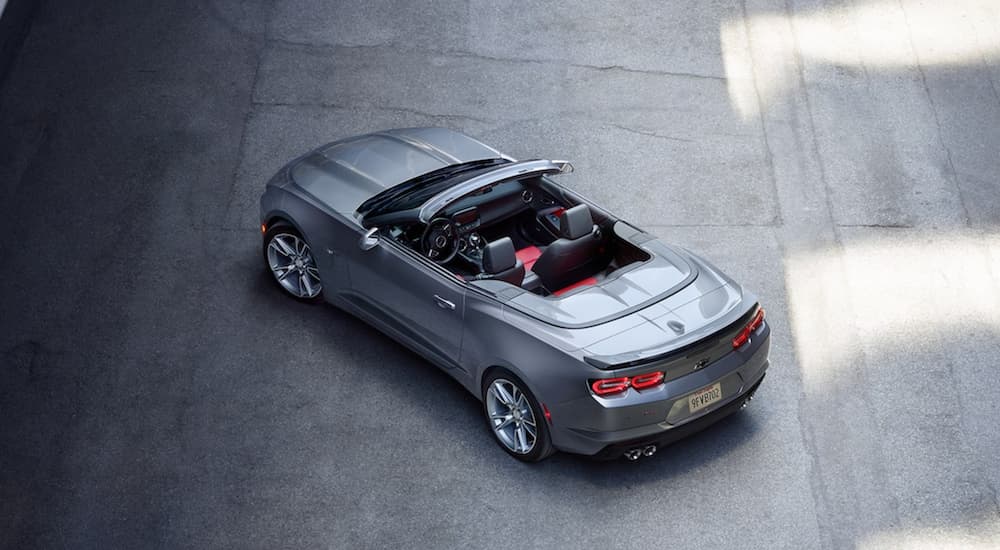As you browse through the well-stocked lots of Chevy dealerships and elsewhere around the country, you might be struck by a thought that has occurred to nearly every speed and power aficionado over the years: What is Chevy’s fastest muscle car?
Currently, Chevy’s performance car throne is maintained by reigning speed champions, the Camaro and the Corvette. The Camaro was introduced in 1966, with the Corvette following rapidly… or shall we say, “with great speed,” in 1967. The car culture of the mid-20th century celebrated speed, power, and performance, and the Camaro and Corvette quickly climbed the ranks to rule the muscle car domain.
Today, the 2021 Chevy Camaro and Chevy Corvette continue this tradition, utilizing very modern technology and engineering advances while paying homage to the muscle car guts and glory that have paved the way to this point. Currently, the 2021 Corvette, with its new middle engine design, holds the title of Chevy’s fastest muscle car. But it’s important to give much respect to the many high-performance models that have helped Chevrolet retain its muscle car reputation over the years.

Second Place: The 2021 Chevy Camaro
Saying the Camaro is slower than the Corvette is almost splitting hairs. But the measurement of time wavers for no man, woman, or muscle car. While the 2021 Camaro ZL1 blazes through a 0-60 mile per hour acceleration in just 3.5 seconds, the Corvette requires a mere 3 seconds.
It can be argued that they are both very different cars and that speed is influenced by a variety of factors, including size, weight, aerodynamics, balance, launch, tires, and the direction of the breeze on any given day. What cannot be argued is that 3.5 seconds is still an unbelievably quick amount of time, with enough Gs to plaster anyone to the back of their Recaro sport seat.
For those who are looking for a more moderate muscle car, don’t worry. The 2021 Chevy Camaro ZL1 is the only trim that barks out these figures. The LS and LT trims come with a standard 2.0L Turbo inline-4 engine that merely saunters from 0-60 in around 5.5 seconds, with 275 horsepower and 295 lb-ft of torque. A 3.6L V6 is available on the LT trim, which boosts performance with 335 horsepower and 284 lb-ft of torque to an admirable 5.2 second 0-60 time frame. The LT1 and famous SS trim receive a highly enjoyable 6.2L V8 that tosses its hat into the speed rings with 455 horsepower and 455 lb-ft of torque, resulting in a 4.0-second acceleration.
And at the top of the food chain is the ZL1 trim, with its supercharged 6.2L LT4 V8 megabeast, complete with 650 horsepower and a matching 650 lb-ft of torque. A 1.7L Eaton supercharger is added into the mix to shake things up, and an available 10-speed paddle-shift automatic transmission takes things to the max. Direct injection and variable valve timing technology are on board to keep fuel economy in the reasonable range. The ZL1 gets 14 miles per gallon city and 20 miles per gallon highway for manual transmission models, and automatic versions providing 13 miles per gallon city and 21 miles per gallon highway. The ZL1 also features standard magnetic ride control for superior balanced handling, a dual-mode exhaust system, launch control system, and track-tuned brakes to dampen all that power when needed.
2021 Chevy Corvette: The Reigning Speed King
Chevrolet caused quite the uproar when it announced that a mid-engine Corvette was hitting the roads in 2021. While opinions spanned from very excited to extremely disappointed, the engine in practice has demonstrated that placing the engine in the middle of a highly tuned performance car can improve traction, grip, and balance, as most of the weight is distributed to the rear wheels. In fact, early reviewers of the 2021 Corvette were astonished to find overall handling controlled, comfortable, and precise.
In the middle of the 2021 Corvette is a naturally aspirated 6.2L V8 engine. On its own, it provides 490 horsepower and 465 lb-ft of torque. However, when drivers choose to add on the Z51 Performance Package, those numbers climb to 495 horsepower and 470 lb-ft of torque.
The Z51 Performance Package can be added to any Corvette trim and includes all of the components that add up to that 0-60 mile per hour flight in just 3 seconds. This means a performance exhaust system, electronic limited-slip differential, fine-tuned suspension and brakes, more aerodynamics, more cooling power, and performance tires. This includes a composite intake manifold with 8, 210mm runners that provide the highest level of airflow to each and every cylinder. A dry-sump scavenge pump system uses three pumps to maintain an ideal level of oil flow exactly where it’s needed when it’s needed.
Magnetic Ride Control 4.0 is also an important component of Corvette’s quest for speed, with an innovative fluid-based suspension system with metal particles that align, adjust, and adapt to provide steadiness and balance in just 10 to 15 milliseconds. Also on board is a standard 8-speed dual-clutch transmission that provides the control of a manual transmission with the quick-and-nimble action of an automatic transmission.
Honorable Mentions: The Most Powerful Muscle Cars in Chevy History
Chevrolet didn’t just appear on the muscle car scene with a Camaro and a Corvette, though. Given that co-founder Louis-Joseph Chevrolet was a Swiss race car driver, it stands to reason that the brand has maintained a focus on speed and performance throughout its years. The muscle car trend really hit the American automotive scene in the 1960s and 1970s, and Chevrolet stepped up to the plate with what is inarguably the most extensive lineup of muscle cars from an American manufacturer.
The Chevy Biscayne entered the market in 1958, and while it started life as an inexpensive full-size sedan, it received a mega makeover in 1966 when it was granted a 7.0L Big Block 427 V8 engine. This translated into 425 horsepower in a basic, lightweight vehicle, thus transforming the Biscayne from “just a car” to one of the pioneer muscle cars.
The Chevelle is another example of a vehicle that started as a car but then gained its muscles. While the more mild-mannered Chevelles were equipped with a choice of a 4.6L V8 220 horsepower or a 5.3L V8 310 horsepower engine, the Super Sport 396 version launched in 1966 came equipped with a 6.5L V8 that made the trip from 0-60 miles per hour in just 6.5 seconds, thanks to its impressive 375 horsepower.
The SS396 eventually made the journey from trim level to optional equipment package but never lost the pep. As the Chevelle metamorphosed into the Malibu, the El Camino, and took on a variety of coupe, sedan, and station wagon shapes, engine power varied. Still, the 1969 SS396 Chevelle has a place in muscle car history.
Chevy Has a Need for Speed
While the 2021 Corvette is currently Chevy’s fastest performance vehicle, it’s impossible to say how long it will wear this particular crown. As history has demonstrated, it’s simply a matter of engineering prowess, along with the right technology, the ideal body style, and consumer demand to transform a simple sedan into a lightning-fast muscle car. The 2021 Camaro and Corvette both proudly demonstrate Chevy’s long-term commitment to performance and speed.
Still, Chevy may have more tricks up its sleeve. Given that moving the engine to the middle of the vehicle has created monumental agility and speed in the Corvette, what might be next for the manufacturer of muscle cars? Chevy might still surprise the public with a vehicle that defies physics as we know it.





